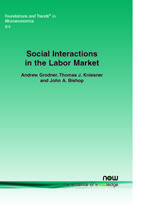Social Interactions in the Labor Market
By Andrew Grodner, Department of Economics, East Carolina University, USA | Thomas J. Kniesner, Department of Economics and Center for Policy Research, Syracuse University, USA and IZA, Germany, tkniesne@maxwell.syr.edu | John A. Bishop, Department of Economics, East Carolina University, USA
Abstract
We examine theoretically and empirically social interactions in labor markets and how policy prescriptions can change dramatically when there are social interactions present.
Spillover effects increase labor supply and conformity effects make labor supply perfectly inelastic at a reference group average. The demand for a good may also be influenced by either a spillover effect or a conformity effect. Positive spillover increases the demand for the good with interactions, and a conformity effect makes the demand curve pivot to become less price sensitive. Similar social interaction effects appear in the associated derived demands for labor.
Individual and community factors may influence the average length of poverty spells. We measure local economic conditions by the county unemployment rate and neighborhood spillover effects by the racial makeup and poverty rate of the county. We find that moving an individual from one standard deviation above the mean poverty rate to one standard deviation below the mean poverty rate (from the inner city to the suburbs) lowers the average poverty spell by 20–25 percent.
We further consider overall labor market outcomes by examining theoretically the socially optimal wealth distribution. Interdependence in utility can mitigate the need to transfer wealth to low-wage individuals and may require them to be poorer by all objective measures.
Finally, we quantify how labor market policy changes when there are household social interactions. Labor supply estimates indicate positive economically important spillovers for adult U.S. men. Ignoring or incorrectly considering social interactions can mis-estimate the labor supply response of tax reform in the United States by as much as 60 percent.
Social Interactions in the Labor Market
Social Interactions in the Labor Market addresses the following questions: How do theoretical economic models and their associated econometric representations change when there are social interactions among households? How do policy implications change as the result of estimated households' social interactions? The authors present a unified theoretical and empirical representation of social interactions as they pertain to labor supply and demand and demonstrate the cases where current policy prescriptions are greatly altered by the presence of social interactions. Section 2 examines theoretically the effect of household interdependencies on how a researcher estimates and interprets labor supply and earnings equations. Having examined labor supply issues, Section 3 and give theoretical attention to labor demand. As a further demonstration how the presence of social interactions complicates thinking about economic policy the authors consider overall labor market outcomes and related economic policy further in Section 4 by examining theoretically the socially optimal wealth distribution. Section 5 measures local economic conditions by the county unemployment rate and neighborhood spillover effects by the racial makeup and poverty rate of the county. Lastly, Section 6 examines the econometric details of implementing an empirical model with possible social interactions in labor supply.
